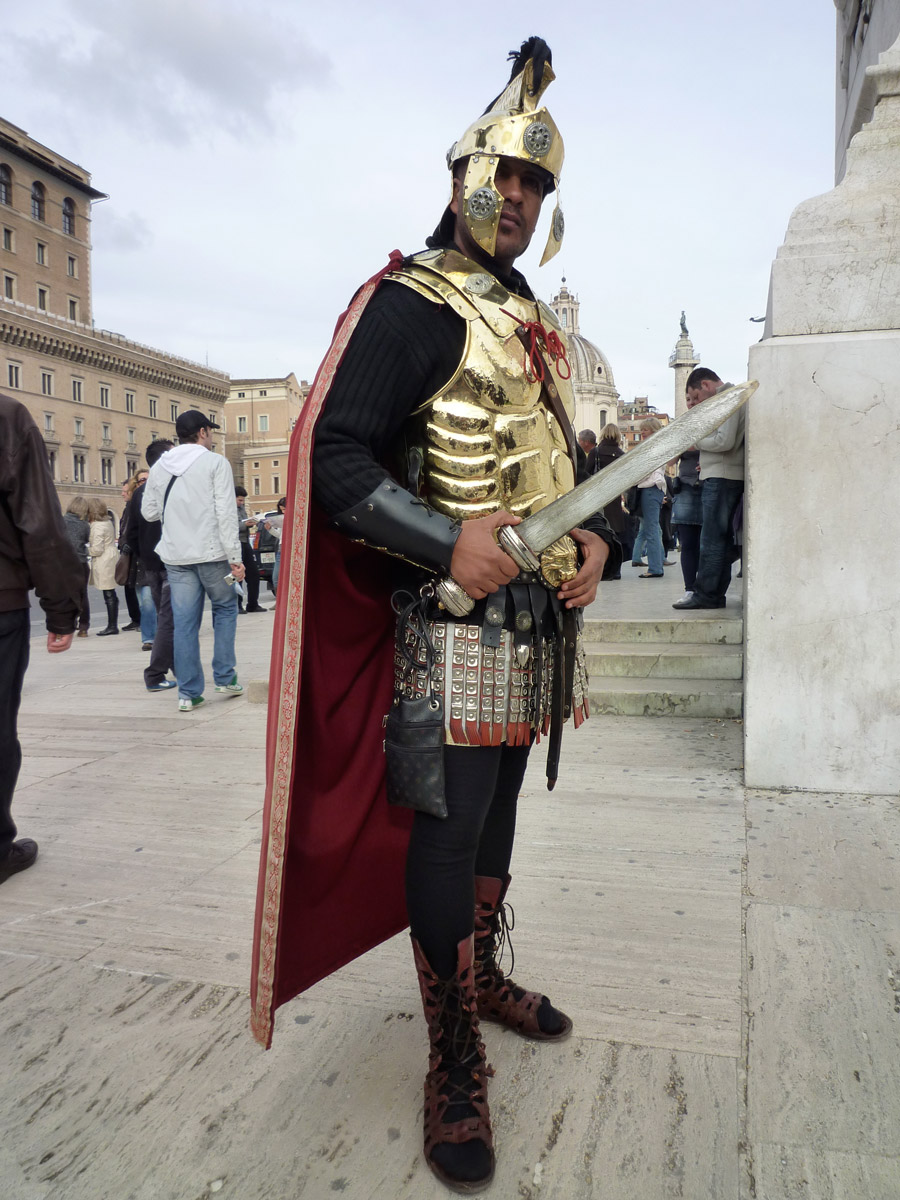It was the middle of January. It had rained all day, but the sun had finally broken through. There was a noticeable dearth of tourists in Piazza Venezia, even for such an offseason time of year. On the lookout for customers, the guys in gladiator outfits were more aggressive than usual, stopping anyone they could find who happened to be carrying a camera.
“Ciao bello,” (“Hey handsome”) barked a surprisingly queer-sounding south Asian in body armor, brandishing a flimsy plastic sword. “Would you like to have your picture taken with me?”
Basking in the irony of being a foreigner solicited by another foreigner to have my picture taken by another, in “drag” as an armed slave of the late Roman empire, was irresistible. “No,” I replied, cracking a smile. “However, if it’s cool, I’d be grateful if I could take a picture of you instead.” “No problem,” responded the gladiator, revealing a very mild British accent. “I’d be happy to pose.”
Two Euros later, I was the proud owner of the best visual proof I could have found of the contradictions of contemporary Italian identity: A photograph of an Indo-Pakistani, quite possibly of British origin, dressed in the local equivalent of a Confederate gray uniform from the Civil War. I should have paid him more.
Paradoxically, although South Asians are the least iconographic of today’s Italian immigrants, they are among the most familiar examples of the country’s increasingly multicultural character. Though not as common in Rome as in my ex-neighborhood, in Milan, south Asians are almost as ubiquitous as French-speaking central Africans and Arabs from the Maghreb.
“Most South Asians here are Sri Lankan,” a Milanese friend informed me. “The Italians don’t like them, but like the Filipinos who come to work here, most are Catholic, which is reassuring.” Much to our surprise, during our first week in Milan, my wife and I found ourselves stuck in a demonstration in Piazzale Cadorna, full of crucifix-wearing south Asians waving Sri Lankan flags in front of a medieval castle. I thought it was bizarre.
As someone who spent part of his childhood in London, attending school with Pakistanis, South Asian immigrants have always been familiar. Being Israeli, I was taught to classify them into two categories: Muslim and non-Muslim (meaning Indian). Sri Lankans were always more of an anomaly, despite being a former British colony. As an adult, I’d only recently started to seriously think about the country when I became an MIA fan.
As though to affirm the trust accorded to local Sri Lankans, a waiter at a neighborhood sushi place I frequented (not the actual place he worked), who originally hails from Colombo, told me he had spent a summer working for one of the senior most leaders of Italy’s leading anti-immigrant party, the Lega Nord, or Northern League, currently governing the country in coalition with Silvio Berlusconi’s Il Popolo della Liberta party.
“I crewed on their yacht,” he said.
According to Vincent (not his real name), the Sri Lankan wasn’t the only person of color to work for this particular Italian politician. Apparently there were other migrants in their employ, none of whose legal status was entirely clear, including that of Vincent. Still, it wouldn’t be the first time that an Italian rightist had broken their own rules. Nonetheless, being unfamiliar with Italian ethnic politics, I was surprised.
For example, not long after our arrival in Milan, Silvio Berlusconi spoke to a Lega Nord rally in the city, bemoaning how much downtown looked like “Africa” and reiterating his desire to prevent Italy from becoming a multicultural society. Yet, the crowning scandal of his current term in office is an affair with a seventeen-year-old Moroccan belly dancer.
So, the idea of an avowedly racist politician, cruising the Adriatic on a vessel manned by possibly illegal South Asian men, should, at least by Italian standards, not be considered extraordinary. If the boss indulges the services of hot girls from the Global South, why shouldn’t the chief anti-immigration advocates be similarly entitled? They’re all hypocrites, naturally. That’s what it means to be in charge.
Reviewing the press during the Prime Minister’s crisis over his relationship with Karima “Ruby” el-Mahroug, what’s been most curious has been how little discussion there’s been of Berlusconi’s transgression of ethnic boundaries. Had everyone become so used to the contradictions of Berlusconi’s behavior that they had stopped appreciating what was significant about his choice in sexual partners? It ought to be discussed.
For example, how could the Prime Minister pay Muammar Gaddafi to limit immigration from Libya, helping the dictator inter illegal migrants headed to Italy in Italian-funded detention camps, but then consort with sexy Arab minors, going so far as to protect them from his own police forces, already charged with the task of rounding up illegal immigrants? What’s wrong with this picture? What does it say about the community envisioned by anti-immigration advocates, and Islamophobes, on the European right?
When it comes to pleasure, ethnicity is not an issue. Berlusconi’s impurities can be ascribed to the primacy he accords his desire. To criticize the Prime Minister for double standards in his sexual relations by pointing out the ideological contradictions in matters of the heart would be unfair. After all, passion can never be deported. The libido cannot be a migrant worker, as ‘worker’ is a universal category. Sexual relations are inherently multicultural.
Disregard Berlusconi’s gaffes about Hitler and Mussolini. They lead people to confuse his acceptance of difference with their racism. What’s significant about such outbursts is their appreciation of fascism’s resolve, and the difficulty conservatives have expressing that outside of the bounds of discriminatory language. Thus, when he jokes about Obama’s “tan” skin color, or expresses his desire that Italy remain “Italian”, what Berlusconi is really saying is that he’s willing to tolerate multiculturalism, but not democracy. At least not the kind that would allow a mixed-race American to be his equal.
Hence the figure of South Asian men in gladiator outfits, trolling for customers in the Piazza Venezia within sight of Rome’s legendary colosseum. Their choice of outfit is key, not just in terms of location, but identity as well. Gladiators were slaves, some of whom were allowed to fight their way to freedom. Provided arms to kill each other, their primary job was to entertain freemen and in the process display the empire’s best values. Romans exalted them. Yet most gladiators spent their lives in bondage.
This tension, between being heroes and slaves, between bondage and emancipation, was fundamental to ancient Rome’s proto-multiculturalism. The point is that the opportunity of equality was often there. One which still characterizes the fate of immigrants like Karima el-Mahroug, and the guy who approached me. El-Mahroug was reasonably successful in emancipating herself. The Prime Minister paid her off and set her up. Who knows whether the gentleman who posed for me will find a similarly benevolent sugar daddy.







Neat.
I remember a spoof of Shakira’s Waka Waka teasing the PM of “risking jail because of Africa”
I would love to see that. Thanks for the tip, Anna.